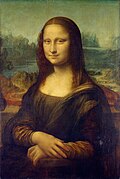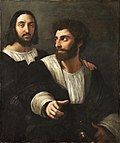
The Louvre, or the Louvre Museum, is a national art museum in Paris, France, and one of the most famous museums in the world. It is located on the Right Bank of the Seine in the city's 1st arrondissement and home to some of the most canonical works of Western art, including the Mona Lisa,Venus de Milo, and Winged Victory. The museum is housed in the Louvre Palace, originally built in the late 12th to 13th century under Philip II. Remnants of the Medieval Louvre fortress are visible in the basement of the museum. Due to urban expansion, the fortress eventually lost its defensive function, and in 1546 Francis I converted it into the primary residence of the French kings.

Frans Hals the Elder was a Dutch Golden Age painter. He lived and worked in Haarlem, a city in which the local authority of the day frowned on religious painting in places of worship but citizens liked to decorate their homes with works of art. Hals was highly sought after by wealthy burgher commissioners of individual, married-couple, family, and institutional-group portraits. He also painted tronies for the general market.

The Musée d'Orsay is a museum in Paris, France, on the Left Bank of the Seine. It is housed in the former Gare d'Orsay, a Beaux-Arts railway station built between 1898 and 1900. The museum holds mainly French art dating from 1848 to 1914, including paintings, sculptures, furniture, and photography. It houses the largest collection of Impressionist and post-Impressionist masterpieces in the world, by painters including Berthe Morisot, Claude Monet, Édouard Manet, Degas, Renoir, Cézanne, Seurat, Sisley, Gauguin, and van Gogh. Many of these works were held at the Galerie nationale du Jeu de Paume prior to the museum's opening in 1986. It is one of the largest art museums in Europe.

The Mona Lisa is a half-length portrait painting by Italian artist Leonardo da Vinci. Considered an archetypal masterpiece of the Italian Renaissance, it has been described as "the best known, the most visited, the most written about, the most sung about, [and] the most parodied work of art in the world." The painting's novel qualities include the subject's enigmatic expression, monumentality of the composition, the subtle modelling of forms, and the atmospheric illusionism.

Ferdinand Victor Eugène Delacroix was a French Romantic artist who was regarded as the leader of the French Romantic school.

The Museo del Prado, officially known as Museo Nacional del Prado, is the main Spanish national art museum, located in central Madrid. It houses collections of European art, dating from the 12th century to the early 20th century, based on the former Spanish royal collection, and the single best collection of Spanish art. Founded as a museum of paintings and sculpture in 1819, it also contains important collections of other types of works. The numerous works by Francisco Goya, the single most extensively represented artist, as well as by Hieronymus Bosch, El Greco, Peter Paul Rubens, Titian, and Diego Velázquez, are some of the highlights of the collection. Velázquez and his keen eye and sensibility were also responsible for bringing much of the museum's fine collection of Italian masters to Spain, now one of the largest outside of Italy.

A masterpiece, magnum opus, or chef-d'œuvre is a creation that has been given much critical praise, especially one that is considered the greatest work of a person's career or a work of outstanding creativity, skill, profundity, or workmanship.

Liberty Leading the People is a painting of the Romantic era by the French artist Eugène Delacroix, commemorating the July Revolution of 1830 that toppled King Charles X. A bare-breasted “woman of the people” with a Phrygian cap personifying the concept and Goddess of Liberty, accompanied by a young boy brandishing a pistol in each hand, leads a group of various people forward over a barricade and the bodies of the fallen while holding aloft the flag of the French Revolution — the tricolour, which again became France's national flag after these events — in one hand, and brandishing a bayonetted musket with the other. The figure of Liberty is also viewed as a symbol of France and the French Republic known as Marianne. The painting is sometimes wrongly thought to depict the French Revolution of 1789.
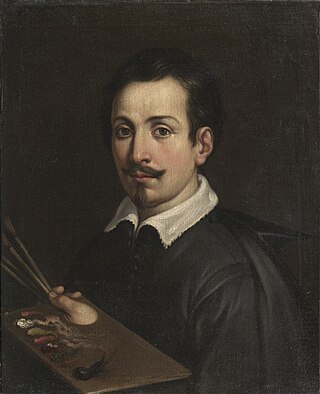
Guido Reni was an Italian Baroque painter, although his works showed a classical manner, similar to Simon Vouet, Nicolas Poussin, and Philippe de Champaigne. He painted primarily religious works, but also mythological and allegorical subjects. Active in Rome, Naples, and his native Bologna, he became the dominant figure in the Bolognese School that emerged under the influence of the Carracci.
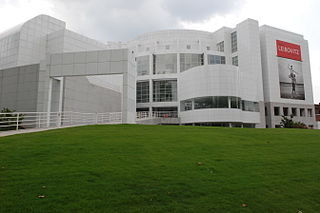
The High Museum of Art is the largest museum for visual art in the Southeastern United States. Located in Atlanta, Georgia, the High is 312,000 square feet and a division of the Woodruff Arts Center.
Art destruction is the decay or material destruction of original works of art. This can happen willfully, accidentally, or through natural processes.

Judith Beheading Holofernes is a painting of the biblical episode by Caravaggio, painted in c. 1598–1599 or 1602, in which the widow Judith stayed with the Assyrian general Holofernes in his tent after a banquet then decapitated him after he passed out drunk. The painting was rediscovered in 1950 and is part of the collection of the Galleria Nazionale d'Arte Antica in Rome. The exhibition 'Dentro Caravaggio' Palazzo Reale, Milan, suggests a date of 1602 on account of the use of light underlying sketches not seen in Caravaggio's early work but characteristic of his later works. The exhibition catalogue also cites biographer artist Giovanni Baglione's account that the work was commissioned by Genoa banker Ottavio Costa.

Giorgio Morandi was an Italian painter and printmaker widely known for his subtly muted still-life paintings of ceramic vessels, flowers, and landscapes—their quiet, meditative quality reflecting the artist's rejection of the tumult of modern life.

Souvenir de Mortefontaine is an oil-on-canvas painting by French artist Jean-Baptiste-Camille Corot, created in 1864. It is a scene of tranquillity: a woman and children quietly enjoying themselves by a glass-flat, tree-flanked lake. It is held in the Louvre, in Paris.

Salvator Mundi is a painting attributed in whole or part to the Italian High Renaissance artist Leonardo da Vinci, dated c. 1499–1510. Long thought to be a copy of a lost original veiled with overpainting, it was rediscovered, restored, and included in an exhibition of Leonardo's work at the National Gallery, London, in 2011–2012. Christie's, which sold the work in 2017, stated that most leading scholars consider it an original work by Leonardo, but this attribution has been disputed by other leading specialists, some of whom propose that he only contributed certain elements; others believe that the extensive restoration prevents a definitive attribution.

Saint Apollonia is a 1636 oil-on-canvas painted by the Spanish artist Francisco de Zurbarán. It is currently held and exhibited at the Louvre in Paris.
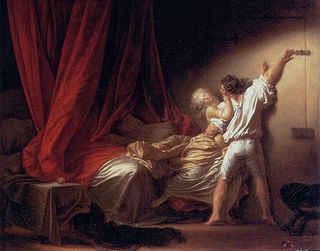
The Bolt, also known as The Lock, is a galant scene painted by Jean-Honoré Fragonard in 1777. It is one of the most famous paintings by the painter. The common interpretation suggests that the scene depicts two lovers entwined in a bedroom, the man locking the door. The painting is preserved in the Louvre Museum, in the section of the Department of Paintings devoted to eighteenth-century French painting on the second floor of the Sully wing. It stands together with some of the most famous pictorial masterpieces of the same period, in a chronologically organized path. This painting, a true symbol of the libertine spirit of the 18th century, reflects the state of mind adopted by the painters of the era, notably that of François Boucher, one of Fragonard's teachers and a great representative of rococo painting.

Le Palais Ducal or The Doge's Palace is the name given to various oil paintings which depict the Doge's Palace made by Claude Monet during a visit to Venice in 1908.
































